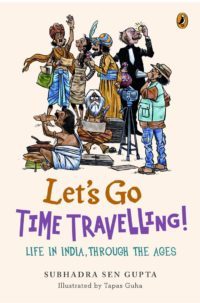RELEVANCE: 3.5/5
RESEARCH: 2.5/5
ENTERTAINMENT QUOTIENT: 3.5/5
Even after spending hours after hours cramming up historical events and dates in our schooling years, how much of history do we really remember today?
Out of sight is out of mind and history never did occur in our sight.
So, is learning and knowing it actually so important?
Well, learning it is indeed important because the understanding of all that we are today and all that we may become tomorrow is crucially based on knowing our histories and knowing them well.
In such a scenario, it is imperative that history is taught in such a way which promotes understanding and retention rather than mindless cramming up.
Let’s Go Time Travelling! by Subhadra Sen Gupta is a classic example of a lesson which our education system may want to take in terms of designing the classroom books and contents.
The book is a perfect example of how you can possibly make a dull and insipid subject which the children hate to study into something which makes them curious and catches their attention.
This book takes you through the lives of the Indian people throughout the multiple ages and kingdoms, which it has since survived.
Right from the Indus Valley civilization to the descent of Aryans to the Mauryas, Guptas, Cholas, Pandavas, Mughals and ultimately the British, this book takes you through a brief journey to the land of snakes and its rich history.
The way Let’s Go Time Travelling! uses cartoons and simple stories at the onset of each chapter, is indeed quite interesting and makes the whole learning experience a lot of fun.
The information provided does not quite focus on dates and names but more on the overall understanding of what those times were like.
There is a lot of information about the food, the cuisines, lifestyle, the clothing and the pastimes of those people. The idea is to make those times come alive in front of the readers.
Overall, a good tool of learning Indian history and that too in a comprehensive way, this book could be an ideal supplementary to a more academic learning tool and will surely be of great use in overall comprehension.
Not just for kids or school-going children, the book is ideal for anybody who has an interest in Indian history and who wants to have some real fun reading about it.
In fact, I myself am so impressed by this book that I sincerely hope that more such books should be written for all subjects and all streams.
In the end, I give the book three and a half stars for the commendable effort which has gone in its production.
